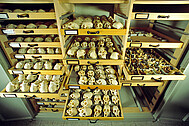Vertebrates
The first successful era of the zoological collections at the museum in Karlsruhe was abruptly ended by the air raids of World War II. The zoological exhibitions with their many large mounted animals and specimens representing all biological groups were completely destroyed, as was the valuable collection of bird skins. Only parts of the skull collection with priceless vouchers from around the world as well as the precious historical collection of molluscs could be rescued. Immediately after the war and simultaneously with the reconstruction of the ruined building the installation of an exhibition on local natural history was begun. Today’s permanent exhibition on "native animals" is still based on the mounted specimens of this period. The former director Erich Oberdorfer formulated then the new goals of the museum: "… to present the characteristics of all the continents on a contemporary level."
In this sense, the collecting activities of the zoologists of the post-war era aimed primarily at the reconstruction of the permanent exhibitions. Helmut Knipper (1914 - 1974) contributed significantly with his journeys to Eastern Africa. The animals exhibited in the "Africa Room" are part of his yield.
One unique feature of the museum is a comprehensive collection of approximately 8,000 skulls of African mammals, which Hans Himmelheber (1908 - 2003), an ethnologist and physician from Heidelberg, collected in Liberia from the leftovers found in the local population's cooking pots. In some areas of West Africa, lifestock farming is not widespread, so the meat demand of the population is met by professional hunters who stalk their prey in the forests. Himmelheber managed to save the skulls of these animals killed for food, preserved them and delivered them to natural history collections back in Germany. After a labor-intensive process of cleaning the heads, most of which were air-dried, they were then scientifically sorted. The species he brought back ranged from chimpanzees, monkeys, civets to small rodents, all in impressive series of several hundred individuals per species. A series of Green Guereza (Procolobus verus) skulls of the same quality cannot be found in any other collection worldwide. The size of this collection today permits scientists to conduct extensive comparative anatomical studies of monkey species which have since become rare. Population ecology studies as well as socio-economic studies are thus feasible: How much "bush meat" was available to the Dan, an ethnic group in Liberia, during the period around 1950? - Was the nutritional status of earlier generations like that of modern times? - How did the need to hunt affect the animal community living there? - Which species lived in the forests of West Africa at the time?
The current curator's activities (Albrecht Manegold) focus on the phylogeny and evolution of birds on the basis of morphological characters. His studies involve the application of CT-scans and 3D-models for the study of spirit specimens. Another area ist the description and analysis of fossil avifaunas from the Pliocene and Pleistocene of south Africa, Morocco and Germany for paleoecological reconstructions.
Further activities are concucted on the ground-dwelling small mammals and the bats of Germany. Many specimens of native small mammals are delivered by local residents - animals found dead, often the prey of cats; or as by-catches from research projects. Sampling is mainly done within the conservation programme entitled "Wild mammals of the state of Baden-Württemberg" and in the case of bats, it is part of the work for the “Coordination Centre for Bat Conservation in Northern Baden,” both of which are under the direction of Monika Braun.
Thus, data on the 78 native mammal species of Baden-Württemberg have been collected and analyzed scientifically by our museum, in collaboration with the Natural History Museum inStuttgart and the State Office of Wildlife Research at Freiburg. Small mammals were trapped with live traps, bat populations are registered and hunting statistics, literature, collections, observations, pellets and carcasses are analyzed. Several research projects on the biology of individual species have been initiated. Through a broad outreach and with the help of many volunteers excellent data have been collected on the occurrence, biology and habitat of these animals as well as factors influencing conservation status, and options for protection. The combined results were published in two volumes of the series "Die Säugetiere Baden-Württembergs".
The collection of native bats currently comprises approximately 7,100 specimens and features 22 of the 24 bat species observed in Baden-Württemberg . The bulk of the material originates from mummiestypo3/ collected during annual district controls in buildings. In addition, the collection includes numerous random findings from different natural environments of North Baden, including rare species such as the barbastelle and the northern bat. These specimens are identified and cataloguedby Monika Braun and Dr. Ursel Häußler.
Curator in charge

Dr. Albrecht Manegold, Dipl.-Biol.
Phone: +49 721 175 2817
E-Mail: albrecht.manegold[at]smnk.de









